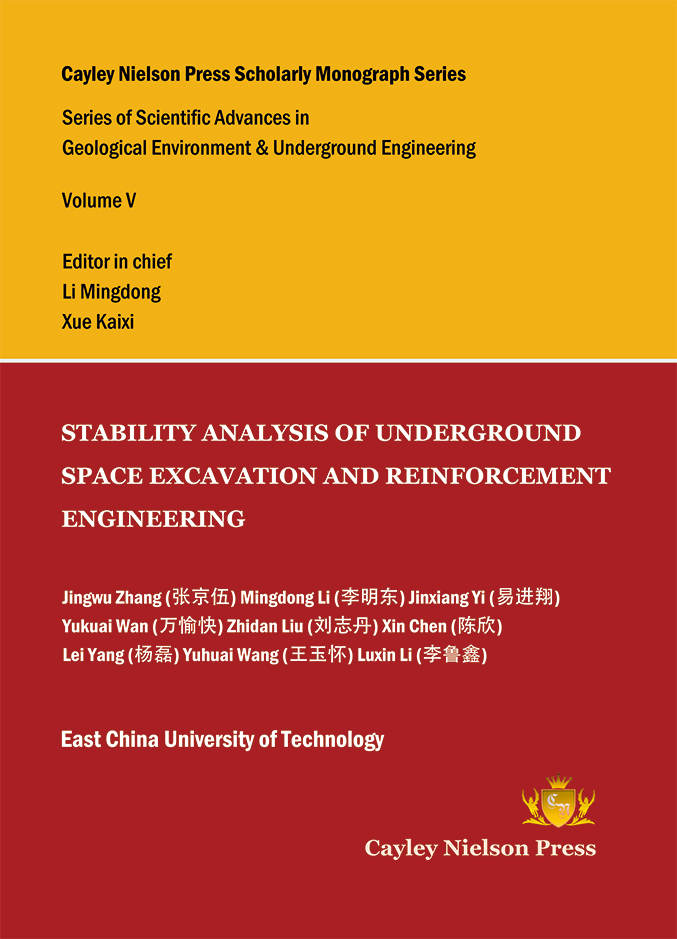
STABILITY ANALYSIS OF UNDERGROUND SPACE EXCAVATION AND REINFORCEMENT ENGINEERING

STABILITY ANALYSIS OF UNDERGROUND SPACE EXCAVATION AND REINFORCEMENT ENGINEERING
Jingwu Zhang (张京伍), Mingdong Li (李明东), Jinxiang Yi (易进翔), Yukuai Wan (万愉快), Zhidan Liu (刘志丹), Xin Chen (陈欣), Lei Yang (杨磊), Yuhuai Wang (王玉怀), and Luxin Li (李鲁鑫)
East China University of Technology
Copyright © 2022 by Cayley Nielson Press, Inc.
ISBN: 978-1-957274-03-4
Cayley Nielson Press Scholarly Monograph Series Book Code No.: 212-4-2
Series of Scientific Advances in Geological Environment & Underground Engineering, Volume I
Editor in chief: Li, Mingdong and Xue, Kaixi(李明东,薛凯喜)
Editors: Yi, Jinxiang; Zhang, Jingwu; Zhu, Liping; Yang, Ting; Xu, Tao; Wang, Shengfu; Shan, Lingzhi; Wan, Yukuai (易进翔,张京伍,朱丽萍,杨婷,许涛,王升福,单凌志,万愉快)
US$150.00
Preface
With the acceleration of urbanization, available land resources become more and more valuable, and the development and utilization of underground space become the inevitable choice. As a space formed by excavation under the ground, the construction of foundation pit is characterized by large number, large scale, difficult technology, complex structure and large investment. A series of comprehensive protection measures, including retaining, reinforcement and drainage, to ensure the stability of main structure and the safety of surrounding environment in foundation pit construction. How to ensure the stability of underground space excavation and take corresponding reinforcement measures is an important content of foundation pit supporting engineering, and there are some textbooks and reference books available on this subject.
Our main goal in preparing this book has been to try to bring to the geotechnical engineering profession a description of stability analysis method that emphasizes both the underpinnings of the methodologies and their practical applications. This book presents the fundamentals of the Stability analysis of underground space excavation and reinforcement engineering within five chapters as an engineering subject. The major contents of this edition include the following:
● Chapter 1 on “Introduction” specifically introduces the main research content of each chapter of this book.
● Chapter 2 on “Stability analysis of fissured foundation pit slopes during excavation” based on the upper bound theorem of limit analysis, solutions are given to evaluate the stability of the fissured slopes subjected seismic action with soil anisotropy and nonhomogeneity properties.
● Chapter 3 on “Stability analysis of fissured foundation pit slopes reinforced with anchor cables” applied the upper bound theorem of limit analysis combined with pseudo-static method to investigate the stability of fissured slopes under seismic load reinforced with anchor cables.
● Chapter 4 on “Stability analysis of slurry- trenches considering soil strength anisotropy and nonhomogeneity” also based on the upper bound theorem of limit analysis, the solutions for analyzing stability of slurry trench with anisotropy and nonhomogeneity properties in terms of soil cohesion are derived.
● Chapter 5 on “Behavior of Underground Reinforced Concrete Retaining Structures for Large-scale Circular Anchorage Foundation Pit” via a long-term field instrumentation program, the structure behaviors performance of the underground retaining systems during excavation is extensively investigated.
Many people have contributed to Stability analysis of underground space excavation and reinforcement engineering and have assisted us in preparing this book. I would like to acknowledge the intellectual contributions of Mingdong Li (East China University of Technology),Jinxiang Yi (East China University of Technology),Yukuai Wan (Ningxia University), Zhidan Liu (Hefei University of Technology), Xin Chen (Suzhou University of Science and Technology), Lei Yang (Ningxia Power Transmission and Transformation Engineering Co. LTD), Yuhuai Wang (Ningxia Power Transmission and Transformation Engineering Co. LTD), and Luxin Li (Ningxia Power Transmission and Transformation Engineering Co. LTD) to Chapters 1 to 5. In addition to those already mentioned, we are deeply grateful to East China University of Technology and Key Laboratory of Ministry of Education for Geomechanics and Embankment Engineering.
Zhang Jingwu
East China University of Technology
Nanchang, Jiangxi, China
February 10,2022
Contents
Preface I
Chapter 1 Introduction 1
Chapter 2 Stability Analysis of Fissured Foundation Pit Slopes During Excavation 5
2.1 INTRODUCTION 5
2.2 UPPER BOUND THEOREM OF FISSURED SLOPE STABILITY 8
2.2.1 Basic assumption 8
2.2.2 Anisotropy and nonhomogeneity of soil strength 9
2.2.3 Definition and formulation of problem 11
2.3 RESULTS AND DISCUSSIONS 18
2.3.1 Comparisons 18
2.3.2 Stability charts 21
2.3.3 Determination of crack location 22
2.3.4 Solution of safety factors 24
2.4 CONCLUSIONS 29
Chapter 3 Stability Analysis of Fissured Foundation Pit Slopes Reinforced With Anchor Cables 32
3.1 INTRODUCTION 32
3.2 METHODOLOGY OF ANALYSIS 35
3.2.1 Basic assumptions 35
3.2.2 Failure mechanism of fissured slopes 36
3.2.3 Upper bound theoretical framework of fissured slopes reinforced with anchors 38
3.3 RESULTS AND DISCUSSION 45
3.3.1 Verification 45
3.3.2 Determination of the critical location of crack 47
3.3.3 Determination of the axial force of anchor cables 48
3.3.4 Determination of the freedom length of anchor cables 55
3.4 CONCLUSIONS 57
Chapter 4 Stability Analysis Of Slurry - Trenches Considering Soil Strength Anisotropy And Nonhomogeneity 60
4.1 INTRODUCTION 60
4.2 UPPER BOUND THEOREM OF SLURRY-SUPPORTED TRENCH STABILITY 62
4.2.1 Anisotropy and nonhomogeneity of soil strength 62
4.2.2 Upper-bound solutions derived using 2D log-spiral mechanism 66
4.3 RESULTS AND DISCUSSIONS 73
4.3.1 Verifications of the calculated results 73
4.3.2 Influence of anisotropy and nonhomogeneity on slurry trench stability 74
4.4 CONCLUSIONS 85
Chapter 5 Behavior Of Underground Reinforced Concrete Retaining Structures For Large-Scale Circular Anchorage Foundation Pit 88
5.1 INTRODUCTION 88
5.2 SITE CONDITIONS 91
5.3 CONSTRUCTION SEQUENCE AND PROCEDURE 94
5.4 INSTRUMENTATION 98
5.5 STRUCTURED BEHAVIORS OF THE CIRCULAR REINFORCED CONCRETE RETAINING SYSTEM 99
5.5.1 Lateral deflection of rock-socketed circular reinforced concrete diaphragm wall 99
5.5.2 Vertical stresses in the rock-socketed circular reinforced concrete diaphragm wall 103
5.5.3 Circumferential Stresses in the circular reinforced concrete lining wall 111
5.6 CONCLUSIONS 116
References 119
Readership
This book should be useful for students, scientists, engineers and professionals working in the areas of optoelectronic packaging, photonic devices, semiconductor technology, materials science, polymer science, electrical and electronics engineering. This book could be used for one semester course on adhesives for photonics packaging designed for both undergraduate and graduate engineering students.
